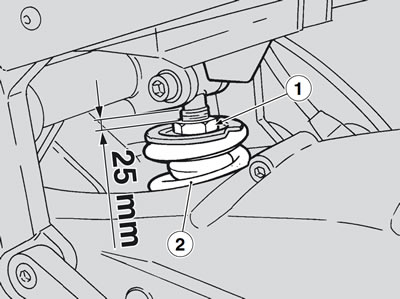The rear suspension is managed by a spring/damper unit that is connected to the frame and to the rear swinging arm through silent-blocks and a linkage system, respectively. To modify vehicle response, the rear shock absorber is fitted with an adjuster nut (1) which controls spring preload (2).

Note. Vehicle geometry may be varied to meet rider's preferences by changing front ride height.
Rear shock absorber adjustment
Factory setting is designed to suit the broadest possible range of riding conditions, meaning low and high speed, whether riding solo or carrying a full load.
However, rear suspension setting may be modified to suit specific needs in accordance with vehicle usage.
Danger!
- Allow the engine and silencer to cool down completely before working the adjusters.
- Never tighten the adjuster nut any deeper than 25 mm from the beginning of the thread (see figure). Exceeding this dimension will result in sudden jerking whenever you come across any small changes in the road surface.
Work the adjuster nut (1) (shock absorber spring preload adjustment) (see table).
Warning!
- Rotate the adjuster nut (1) gradually one turn at a time.
- Test ride the motorcycle repeatedly until achieving the ideal setting.
Rear shock absorber setting table
| Adjuster nut (1) | Tighten | Slacken |
| Purpose | Increase spring preload | Decrease spring preload |
| Vehicle response | Stiffer | Softer |
| Recommended for | Smooth pavement, regular road surface | Uneven or loose road surface |
| Notes | Riding with a passenger | Riding solo |
